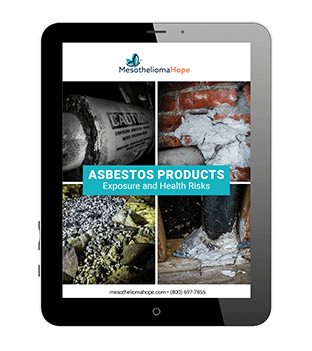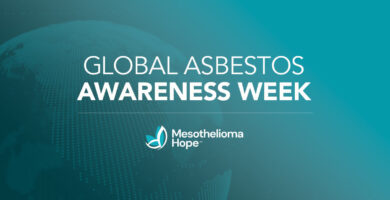Diseases caused by asbestos can be difficult to identify because symptoms may not show up for decades. This means it can be tough to establish a link between exposure and lesser-known asbestos-related diseases. According to the National Cancer Institute (NCI), asbestos-related diseases can be found in individuals with only brief exposure. The best defense is to know your risk.
Asbestos Exposure Diseases
Asbestos is a naturally occurring mineral found in soil and rocks. Because of its resistance to fire, heat, and sound, asbestos was used widely from the 1930s to the 1980s.
Today, it is well known that asbestos is toxic and linked with deadly cancers. However, many people do not realize that there are lesser-known asbestos-related diseases that can develop even after one single exposure.
Many people only think about asbestos as a risk for people in certain jobs or for United States military veterans. While it’s true that more than 90% of asbestos-related deaths are caused by exposure in the workplace, job sites are not the only place asbestos is found.
“Everyone is exposed to asbestos at some time during their life. Low levels of asbestos are present in the air, water, and soil.”
– National Cancer Institute
Unfortunately, asbestos is still not fully banned in the United States and continues to pose a risk, not only for cancer but also for lesser-known asbestos-related diseases.
Asbestos exposure can occur in many places, including:
- Old buildings and homes
- Popcorn ceilings
- Talcum powder
- Near asbestos mines
Being exposed to asbestos just once can cause illness. Asbestos fibers are extremely thin and get released into the air. When they are breathed in, asbestos fibers can get stuck deep in the lungs causing inflammation and scarring.
Two Groups of Diseases From Asbestos
Diseases from asbestos are either cancerous (malignant) or non-cancerous (benign). This is the case with lesser-known asbestos-related diseases as well.
Malignant Diseases From Asbestos
Malignant diseases from asbestos tend to be very aggressive and even deadly. When cells from malignant tumors spread, they can invade other major organs, such as the brain.
Some of the more widely known malignancies include:
- Mesothelioma: This rare cancer is found in the lining of the lungs, abdomen, and heart, with the only proven cause being asbestos exposure.
- Lung cancer: Although lung cancer is far more common than mesothelioma, only about 20% of cases can be directly linked to asbestos exposure.
Ovarian cancer, the deadliest of all women’s reproductive cancers, is linked with asbestos exposure.
Benign Diseases From Asbestos
Benign diseases from asbestos are caused by abnormal cell growth. These illnesses do not spread the same way that cancer does.
Benign diseases linked with asbestos include:
- Asbestosis: This is a chronic disease that occurs when lung tissue becomes scarred.
- Pleural plaques: These are hard structures that occur around the lungs and diaphragm.
While they can usually be treated, benign asbestos diseases tend to be incurable — and some are even fatal.
List of Lesser-Known Asbestos-Related Diseases
Since the effects of asbestos typically don’t appear for 20-50 years after exposure, some lesser-known asbestos-related diseases may not get linked back to asbestos.
“Asbestos exposure can also cause cancer of the larynx and ovary. Current evidence also suggests asbestos exposure may cause cancer of the pharynx, stomach, and colorectum.”
– Agency for Toxic Substances and Disease Registry
Other lesser-known asbestos-related diseases and cancers include:
- Testicular cancer
- Bile duct cancer
- Pleural effusion
- Peritoneal or pericardial effusions
- Diffuse pleural thickening
- Atelectasis (complete or partial collapsed lung)
- Chronic obstructive pulmonary disease (COPD)
It is very important to understand that not everyone who is exposed to asbestos will develop an asbestos-related disease. As with any health condition, the best defense is becoming knowledgeable about your own risk as well as signs and symptoms.
What Are Asbestos Exposure Symptoms?
Asbestos exposure symptoms can vary depending on what type of illness a person has. Since symptoms can take decades to appear, they can be tough to identify. Lesser-known asbestos-related diseases can be especially difficult to diagnose.
Some symptoms of asbestos-related diseases include:
- Shortness of breath
- Wheezing or hoarseness
- A cough that doesn’t go away and gets worse over time
- Blood in fluid coughed up from lungs
- Tightening in the chest
- Pain in the chest
- Swelling of the neck or face
- Weight loss
If you develop any of these symptoms, talk to your doctor without delay. If you believe your symptoms could be related to asbestos, be sure to let your doctor know that you have been exposed.
Are My Symptoms From Asbestos?
It is important to remember that if you have been exposed to asbestos only briefly, it is usually not dangerous. Most people who are diagnosed with asbestos-related diseases were exposed on a regular basis.
That said, to ensure you are screened properly for all conditions, especially some of the lesser-known asbestos-related diseases, your doctor will need to know every instance of past exposure.
What to Do if You Think You’ve Been Exposed to Asbestos
If you think you have been exposed to asbestos, speak with a medical professional. Once asbestos exposure occurs, it can not be reversed. However, preventing additional exposure becomes even more important.
According to the Centers for Disease Control and Prevention (CDC), some steps you can take include:
- Have all recommended medical exams
- Get vaccinated regularly against flu and pneumococcal pneumonia
- Quit smoking
- Avoid further asbestos exposure
If you are diagnosed with an asbestos-related disease, you may wish to contact an attorney. It is important to do this without delay, as there is a limited amount of time victims of asbestos exposure have to file a legal claim.
An asbestos law firm with experience will be knowledgeable about a wide range of issues that asbestos can cause, including legal options for lesser-known asbestos-related diseases.
If you need assistance, our team may be able to help — contact us now to learn more.










